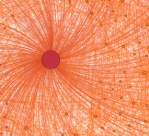The latest beta version of Gephi has been released, download it for Windows, Mac OS and Linux platforms. This release focus on new features for both users and developers, and the new license unlocks opportunities for business. The Ranking and Preview modules have been completely rewritten in a modular way and can be now extended with plug-ins! Preview can now be extended in many ways, for instance group shapes or edge bundling. Moreover, continuous progress have been made on the dynamic network support and we release today the last big part: statistics over time, available from the Statistics module when the network is dynamic. Thanks to users who reported bugs, it’s the only way to fix them.
The team will now start developing the 0.9 version of Gephi (please consider joining us!) and integrate the latest Google Summer of Code projects, including a new timeline. We are also willing to help as much as possible plug-ins developers to get things done and improve documentation. We want to leverage the new Preview and will help newcomers to get started.
Because it’s a major release, changes are not deployed through the AutoUpdate, you need to download and install the new version. Plug-ins also need to be checked for compatibility. They will reappear on the Plugin Center in the coming days, as they are verified. Thanks for your patience.
 Consult the release notes and the new Javadoc for more information.
Consult the release notes and the new Javadoc for more information.
Features highlight
New And Noteworthy
* Data Lab node merging
* ForceAtlas2 layout algorithm, with multi-thread option
* Node and Edge transparency in Preview
* Edge labels on curved edges in Preview
* Text outline now in Preview
* Database importer now supports time columns (start & end)
* DL Export (Thanks to Taras Klaskovsky)
* GML Export (Thanks to Taras Klaskovsky)
* NET Export (Thanks to Daniel Bernardes)
* K-core filter
* Inter and Intra partition filter
* Now supports SQLite databases
* Display the number of layout iterations in status bar when ended
* Recent Palette in Ranking
* Weighted degree now also for directed graphs
New localization (Go to Tools > Languages)
* Portuguese (Brazilian) (Thanks to Célio Faria Jr)
* Japanese (Thanks to Siro Kida and Koji Chono)
Performance
* Memory starvation manager, warns the user before running out of memory
* Less memory usage with attributes
Bug fixes
* Timeline need more precision when dealing with dates (bug 521937)
* Exception on range slider (bug 541808)
* Inconsistent label data from Overview to Preview (bug 660204)
* Statistics: sub-optimal modularity (bug 727701)
* Timeline cann’t drag if the two sliders moved to the left (bug 745476)
* Missing Polish characters when exporting to pdf (bug 746740)
* Edge selection color is not correct on OSX (bug 752300)
* Workspace name truncated, hard to read (bug 758578)
* Average degree cannot be switched to directed / undirected (bug 760454)
* Window->Favorites appears in 0.8 alpha (bug 764494)
* Disable ‘directed’ on metric settings if the graph is undirected (bug 771318)
* Timeline does not work (exception) (bug 774455)
* Layout properties can’t be saved in a language and loaded in another language (bug 783637)
* Preview: edge label not shown (bug 783868)
* Possible memory leak on Dynamic Range Filter (bug 784606)
* Edge attributes not saved in .gephi project file (bug 785268)
* Data Lab: Exception when selecting only one column for merging (bug 785269)
* Data Lab Import Spreadsheet should not ignore parallel edges (bug 785635)
* Data Laboratory: wrong edge type created (mutual instead of directed) (bug 787401)
* Data Lab: impossible to edit time intervals in a date format (bug 793163)
* Spelling of Proportionnal (bug 794358)
* Graphics errors when JOGL installed as a JRE/JDK extension (bug 799545)
* NPE if source/target is empty in GEXF import (bug 799574)
* Toolkit can’t open .gephi files (bug 802101)
* Resizing edge sizes changes edge weight values (bug 803763)
* Preview does not use node label settings from overview tab (bug 805763)
* Data Lab ‘Import Spreadsheet’ dialogue should accept other file types than .csv (bug 806798)
* Edge weights not imported from CSV matrix (bug 808078)
* Preview tab: no option to switch off node borders? (bug 808606)
* Gephi runs out of memory without warning the user (bug 811373)
* Counter-intuitive filename in Data export dialog (bug 814178)
* NullPointerException when creating newProjects too quickly (bug 817170)
* Nodes and edges Id attribute dictionary is not properly created when loading a .gephi file (bug 818181)
* Database driver doesn’t persist in Edge List Database import UI (bug 822316)
* NodeEqualNumberFilter does not work (bug 823038)
* Gephi does not build on JDK 7 (bug 823543)
* SVG node, edge export should include relevant node IDs as classes (bug 827706)
* Import Spreadsheet: need to trim column names (bug 829956)
* Layout list not sorted by name (bug 830149)
* In/Out degree metric is computed on the main graph instead of the visible graph (bug 830752)
* Layout is not giving the algorithm’s number of iterations (bug 831782)
* Banner height issues, need a fixed height (bug 834400)
* NPE when running ClusteringCoefficient on a filtered graph (bug 852799)
* Missing node properties from dot file (bug 855410)
* ‘The value column doesn’t exist’ error when opening a gephi file (bug 857595)
* Import fails for NET (Pajek) file with position/color data (bug 860825)
* GEXF export referes to v1.1 schema, should be v1.2 schema (bug 864484)
New Plug-ins documentation
Checkout the documentation for the newly created Preview module: HowTo write a Preview Renderer. Learn also how to extend the Data Laboratory features in a new tutorial.
New license
Gephi is now released in the dual license CDDL + GNU GPLv3. We abandon the GNU AGPL to offer new opportunities to reuse and integrate parts of Gephi in a full Open Source way. The dual license system means the possibility to choose to apply either the CDDL or the GNU GPLv3 when Gephi source code is integrated to a derivative work. When modified, original files of Gephi should always be published publicly so that the community benefit from the improvements. However, the CDDL license does not require to publish the whole work, so you can build commercial applications for free using Gephi source code!
The CDDL is a license created by Sun and approved by the Open Source Initiative. It is business-friendly. Read the Legal FAQs to learn more, and ask questions on the forum.
Contribute
It’s fun to contribute to an open-source project! Contribute whatever the time you can give: few minutes to report a bug, some hours to fix one or to translate the user interface or more to create a plug-in. If you’re a student and looking for cool and challenging semester projects check out the Gephi Student Program or contact us.
Do Gephi technologies matter for your research or business? You can support us by donating to the Gephi Consortium, or becoming a member to have an impact on our roadmap.
Feel free to reach to us if you are willing to organize events (meetups, workshops, hackathon, etc.), we will support them.





 Tutorial:
Tutorial:  A new release of the
A new release of the 


 Consult the
Consult the 











































